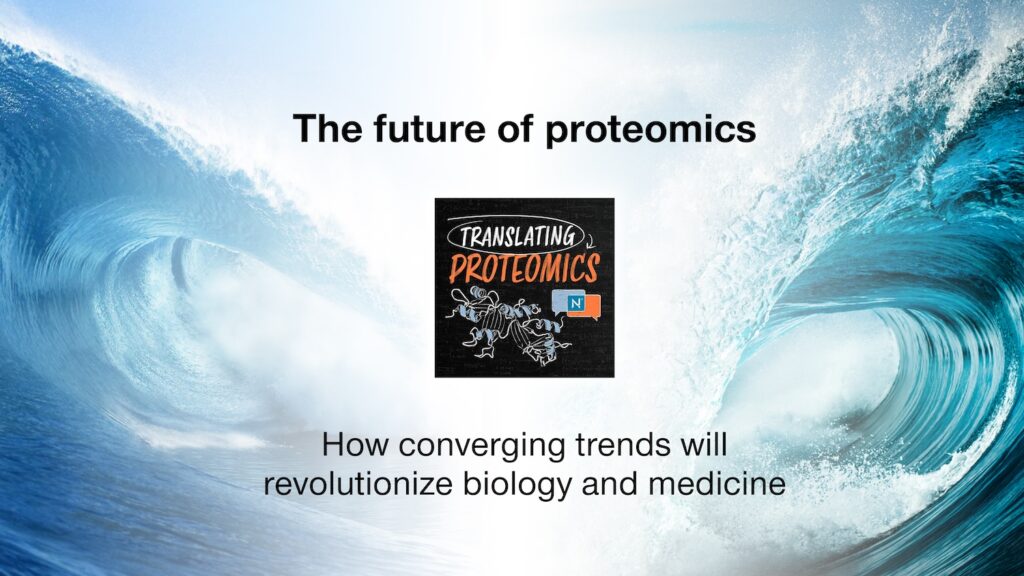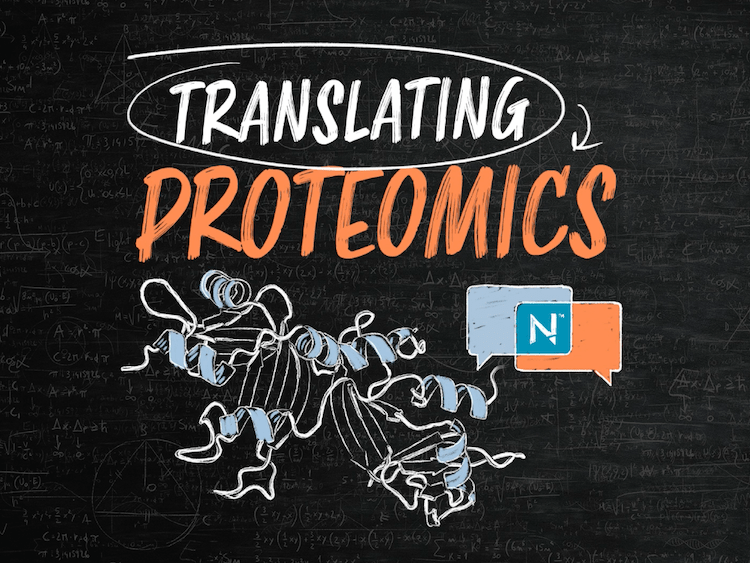
The future of proteomics – How converging trends will revolutionize biology and medicine
Nautilus Biotechnology
August 20, 2024

It’s been just a few short decades since scientists began moving from studying individual proteins to full proteomes. However, the field of proteomics has already advanced by leaps and bounds. That progression has been driven by increasingly advanced technologies that enable proteomic analyses at a scale and speed once unimaginable.
While proteomics has continued to deliver new insights, we’re also at a moment where several converging forces may soon combine to deliver groundbreaking proteomic insights. The coming proteomics revolution could deliver truly astonishing advances in medicine, basic biology, and far beyond, while cementing the proteome’s importance to understanding life itself.
“There’s tremendous inertia,” says Nautilus’ founder and Chief Scientific Officer Parag Mallick, speaking on the first episode of our Translating Proteomics podcast. “My colleague Sharon Pitteri and I teach a proteomics course at Stanford, and if we go back five or six years, we had maybe 20 people in the class. Last year there were 40 people. This year there are 80 people in the class.”
“It feels like we are poised for a breakthrough,” he says.
Why we’re at the cusp of a proteomics breakthrough
On the podcast, Parag and Andreas Huhmer, Nautilus Senior Director of Scientific Affairs and Alliance Management, shared their thoughts on the rapid evolution of the field of proteomics over the past twenty or so years, as well as the recent trends that could be setting the field up for a breakthrough moment. Two of the chief factors, they say, are new technologies and fields like precision medicine driving the need for multiomic insights.
In just the past few decades, advances in sample preparation, ionization, and detection have enabled mass spectrometers to detect hundreds, then thousands of proteins. With a substantial investment of time and intensive bioinformatic analysis, scientists can identify a significant fraction of the proteome. That advance in capabilities even exceeds the rate of progress described by Moore’s Law, which predicts a doubling of transistors on a computer chip every two years, Andreas notes. Even so, proteomics technology needs to be better.
“I still think we’re falling short of a lot of things,” he says. “We really haven’t captured the dynamics of the cellular systems or the biological systems we’re studying.”
Watch Andreas and Parag discuss where current proteomics technologies fall short.
Still, existing proteomics tools regularly demonstrate the immense value of the proteome. That has researchers asking what even better tools might unlock, especially those that would help integrate insights from proteomics with other levels of biology.
Learn how the NautilusTM Proteome Analysis Platform can accelerate proteomics.
The second piece of the puzzle comes from the world of precision medicine. Scientists and doctors now realize that studying the genome and transcriptome alone are not enough to deliver long-sought personalized treatments. Instead, a synthesis of those fields with proteomics is necessary. “We need to combine multiple types of data to do a better job of predicting and understanding biology,” Parag says.
Together, the two trends point to an inescapable conclusion: proteomics will play a crucial role in the scientific and medical advances of the future.
“I feel like we’re at this convergence of two completely disparate waves that are crashing into each other,” Parag says.
Watch Parag and Andreas discuss key developments pushing proteomics forward.
Key advances needed to drive the proteomics revolution
While proteomics is certainly one important key to unlocking new advances in science, we’re not quite there yet. Both Parag and Andreas see a few important, though unrealized advances that are necessary to help proteomics reach its full potential. Chief among them is the need for standardization in proteomics — both in the language used and the technical protocols followed.
The field of proteomics has already converged on a far narrower set of research standards and practices than even 10 years ago, Parag says. To achieve true precision medicine, we’ll need further standardization that includes other levels of biology as well.
“When I think about our next breakthrough, I think there’s a huge analytical component,” Parag says. “How do we combine this data with other data? How do we look at it over time? How do we describe this transition from gene to transcript to protein to proteoform to spatial protein?”
A new naming system for proteomics
“We have a very strange nomenclature for proteins,” Andreas says. Contracting protein names to abbreviations, as many papers do, means “you often lose what these different [names] mean.”
In a more radical leap forward, Parag and Andreas argue we may need a new naming convention for proteins that takes into account the proteome’s dynamic nature.
This is a big task, and one that would need input from the entire community, but the two lay out some ideas for what a new naming system might look like.
Instead of simply giving proteins a name or number, a new naming convention would take into account the fact that proteins can appear and disappear in tissues as biological processes turn on and off.
That would mean naming proteins based not only on their form, but their location and temporality as well.
“We need a unique identifier for a thing, and then we need something to describe its state and trajectory over time,” Parag says.
Watch Parag and Andreas discuss the need for a change in protein nomenclature.
As an example of what this might look like, Parag turns not to the world of biology, but to astronomy. Because Earth orbits the sun, stars appear to move across the sky throughout the year. To find stars, astronomers need to know not just the location but the date. As a result, finding celestial objects is a multidimensional task.
To capture that variability, astronomers have star charts that account for both space and time. Similarly, proteins might appear in specific tissues only at certain times, making time a crucial component of finding them.
“It may be that we just need to expand to a more sophisticated lexicon to describe both identity and trajectory when naming proteins,” Parag says.
Those advances may come in just a few short years. Meanwhile today, new technologies like the Nautilus Platform are designed to accelerate proteomics capabilities, and broaden access to the proteome. Higher throughput, ease of use, and next-generation resolution will take us to the next level of proteomics and beyond.
MORE ARTICLES

